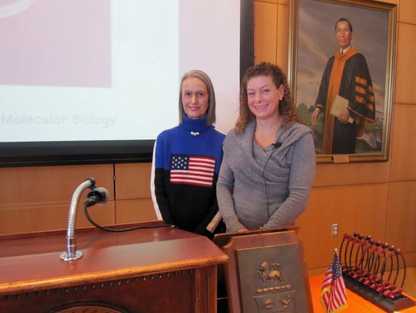January 28, 2015
Molecular Mechanisms of Aging
Coleen Murphy
Associate Professor of Molecular Biology
Director of Paul F. Glenn Laboratories for Aging Research, Princeton University
Molecular Mechanisms of Aging
Coleen Murphy
Associate Professor of Molecular Biology
Director of Paul F. Glenn Laboratories for Aging Research, Princeton University
Minutes of the 16th Meeting of the 73rd Year
Speaker Prof. Coleen Murphy, Princeton University
Owen Leach opened the meeting. Don Edwards led the invocation.
A moment of silence followed the announcement of the death of Gordon Spencer.
The Old Guard Executive Committee will study possible revisions to the policy regarding weather related postponement or cancellation of meetings.
Roland Machold read the minutes of the January 21 meeting.
Attendance was 106, including six guests. Joe Wisnofsky had a guest, Colin Hill.
Richard Bergman had a guest, Millie Harford. Ted Thomas had a guest, Penny Thomas.
Charlie Ascher had a guest, Rod Campbell. Ted Bromley had a guest, Barbara Bromley. B.F. Graham had a guest, Gregory Dobbs.
B.F. Graham introduced the speaker, Prof. Coleen Murphy of Princeton University.
After graduation from The University of Houston in 1992, Prof. Murphy studied at Stanford University and received her doctorate from the University of California-- San Francisco.
The subject of Prof. Murphy’s talk to the Old Guard is The Molecular Mechanisms of Aging.
Prof. Murphy explained that the laboratory model she uses is the nematode because the entire genome of the nematode has been identified and sequenced. Specifically, the model is Caenorhabditis Elegans, a combination of Greek and Latin meaning Elegant Rod, generally referred to as C.Elegans.
In plain English, the nematode is a small roundworm about one millimeter in length. To give you another idea of its size, there are 26 millimeters to an inch. It is the first animal to have its entire genome identified and sequenced.
This worm shares several aging traits with humans: it slows down with age, its skin becomes winkled; its ability to sense its environment declines. These worms have a lifespan of two to three weeks and their signs of aging are visible on both the gross and the microscopic level.
By using a model system with a short lifespan, Prof. Murphy is able to identify genes that are critical for the maintenance of health.
Respectfully submitted
John Timoney
Owen Leach opened the meeting. Don Edwards led the invocation.
A moment of silence followed the announcement of the death of Gordon Spencer.
The Old Guard Executive Committee will study possible revisions to the policy regarding weather related postponement or cancellation of meetings.
Roland Machold read the minutes of the January 21 meeting.
Attendance was 106, including six guests. Joe Wisnofsky had a guest, Colin Hill.
Richard Bergman had a guest, Millie Harford. Ted Thomas had a guest, Penny Thomas.
Charlie Ascher had a guest, Rod Campbell. Ted Bromley had a guest, Barbara Bromley. B.F. Graham had a guest, Gregory Dobbs.
B.F. Graham introduced the speaker, Prof. Coleen Murphy of Princeton University.
After graduation from The University of Houston in 1992, Prof. Murphy studied at Stanford University and received her doctorate from the University of California-- San Francisco.
The subject of Prof. Murphy’s talk to the Old Guard is The Molecular Mechanisms of Aging.
Prof. Murphy explained that the laboratory model she uses is the nematode because the entire genome of the nematode has been identified and sequenced. Specifically, the model is Caenorhabditis Elegans, a combination of Greek and Latin meaning Elegant Rod, generally referred to as C.Elegans.
In plain English, the nematode is a small roundworm about one millimeter in length. To give you another idea of its size, there are 26 millimeters to an inch. It is the first animal to have its entire genome identified and sequenced.
This worm shares several aging traits with humans: it slows down with age, its skin becomes winkled; its ability to sense its environment declines. These worms have a lifespan of two to three weeks and their signs of aging are visible on both the gross and the microscopic level.
By using a model system with a short lifespan, Prof. Murphy is able to identify genes that are critical for the maintenance of health.
Respectfully submitted
John Timoney

